Gubbio is one of the largest and best-preserved medieval towns in all of Italy. Most travelers, even if you're very experienced, have never heard of the town of Gubbio in Umbria in Italy. Well we are going to take you there so you can discover how wonderful it is. Gubbio is not on the train line, which has helped to keep it less crowded than many of Italy's well-known destinations, but can be easily reached by bus, for example from Perugia in one hour.
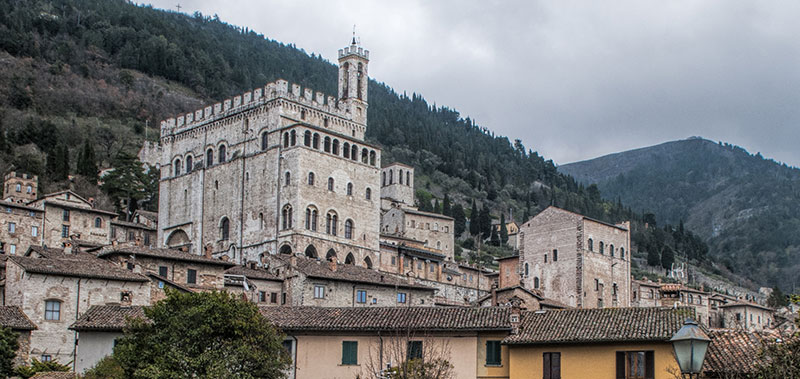
We're in Umbria and very fortunate to be walking with Isabella, a knowledgeable local, who is going to take us around and show us the great sights of this amazing town. It's about 1000 years old but it has origins that go back 3000 years, with a lot of history. Isabella is not a professional tour guide, but she's born and raised in Gubbio and very enthusiastic about her hometown.
Part 1: Gubbio, in Umbria, is one of the largest and best-preserved medieval towns in Italy. We bring you on a walking tour with local expert Isabella Ceccarelli, who takes us to the old San Martino neighborhood, with narrow lanes, a picturesque stream and ancient stone buildings.
Part 2: Palazzo dei Consoli, built 700 years ago, is the grandest building in Gubbio, a well-preserved medieval town in Umbria, Italy. The palace is enormous, reaching nearly 250 feet high like a skyscraper from the Middle Ages, and contains the main art and history museum of Gubbio. Our local friend Isabella Ceccarelli brings us also to the Piazza Grande and the City Hall, the Palazzo del Podesta.
Part 3: Gubbio is best seen on foot, as we visit the Palazzo Ducale and walk the narrow lanes of this Umbria town, then ride up the Funivia, a cable-car more like an open birdcage on a wire, taking us up the mountain for a fine view back over the city.
Part 4: Visiting some neighborhood shops gives us a look at life in Gubbio, Italy, an ancient walled city with a small-town atmosphere of friendly people and traditional commercial activities.
Part 5: Truffles are found in abundance in the hills around Gubbio, Umbria in Italy. We visit Francesca's truffle shop, Tartufi di Gubbio, and devour dinner at a lovely restaurant, San Francesco e il Lupo, which serves truffle pizza and a truffle tasting menu.
Part 6: Dinner at home with Isabella and family in Gubbio, Umbria, in Italy, was one of those special travel experiences that only happen once in a rare while and make you feel like a resident instead of a visitor. The large dining room was a medieval tavern, big enough for the kids to play soccer on roller skates while we sample the wines and enjoy a great meal!
"I am Isabella. I live in Gubbio. I am born in Gubbio, and Gubbio is my town. It's very, very beautiful. You come with me for one walk in Gubbio. It's okay?"
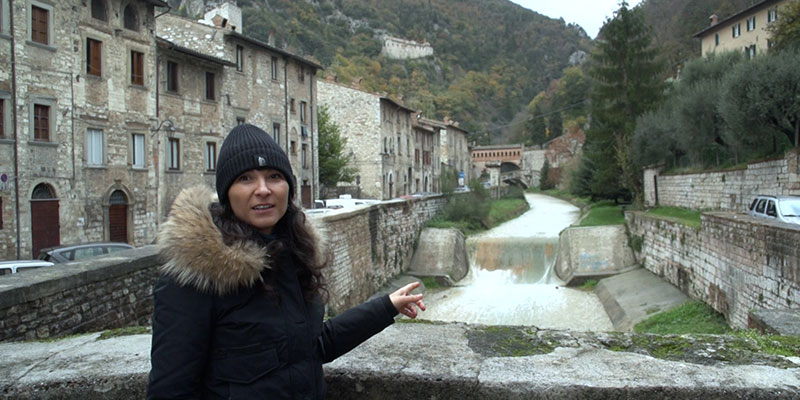
Let's begin our walk in a very old part of Gubbio, the district of San Martino. We cross the little stream that runs through town into San Martino, which is a charming neighborhood with winding lanes and little cafés and neighborhood shops very old buildings. This river is Camignano, and in springtime, the children play football because in the springtime, there is no water.
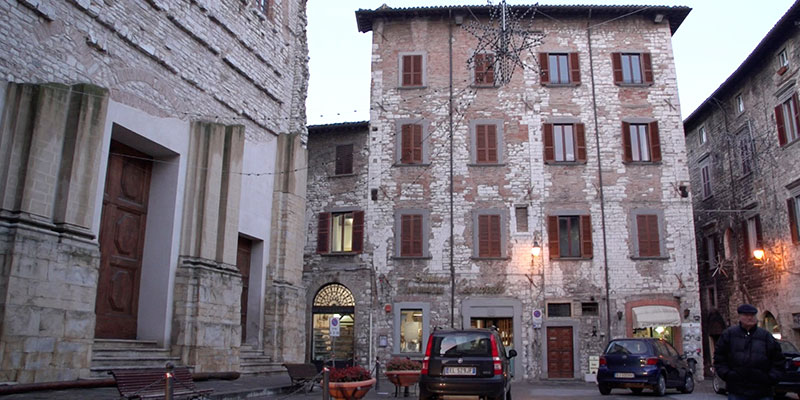
We soon reach Piazza Giordano Bruno, the main piazza in San Martino. The piazza is named after Giordano Bruno, a Dominican friar, and there's the church of San Domenico right on the piazza, so there is a connection between those two.
Interesting to notice the two layers of church façade – you have the original stone front and then we have a later façade that was added and partly broke off.
Giordano Bruno was a great intellect back in the late 1500s, but unfortunately, he was burned at the stake for his beliefs that there were many universes and that the Earth rotated around the sun. Bruno believed that stars had planets around them just like our solar system, heretical beliefs for the Catholic Church.
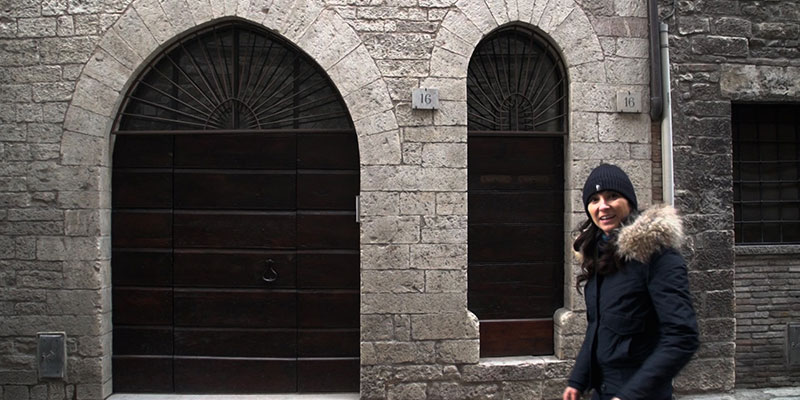
The narrow door on the right side is the "door of the dead," which is a curious feature unique to Gubbio. They are quite proud of these "doors of the dead" found in many of the old buildings and yet nobody is quite sure what they were used for. One belief is the door was used for removing people who died inside the building, or another opinion is that it was a door that the owner could use for more security.

A mysterious round stone section of paving in the street is believed to be an artifact left over from the earliest days of Gubbio, from the time of the Umbri, the earliest settlers over 2000 years ago, and yet its function is unknown.
And this is the palace of Capitano del Popolo. He was captain of the people, which was a very important person in Italy back in the Middle Ages – he was like the mayor of the city. He was a countervailing power to the nobles. Hence, the Captain of the People was a representative of the wealthy merchant class growing in power and rivaling the nobility.
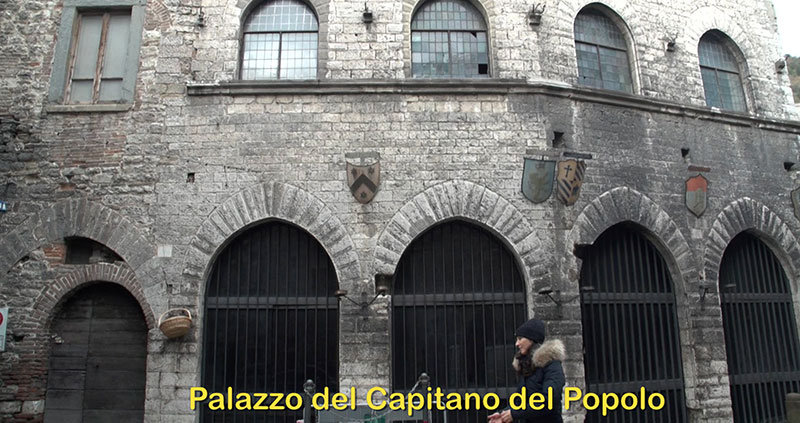
The Popolo had their own army, councils, and legal system and played a very important role in the political life of Italian cities in the Middle Ages.
This old neighborhood has a fine example of a medieval tower. These were like skyscrapers in the Middle Ages. They were for protecting the household in case of attack. Just wandering through these pleasant lanes in the small district of San Martino was one of my favorite parts of the entire visit to Gubbio.
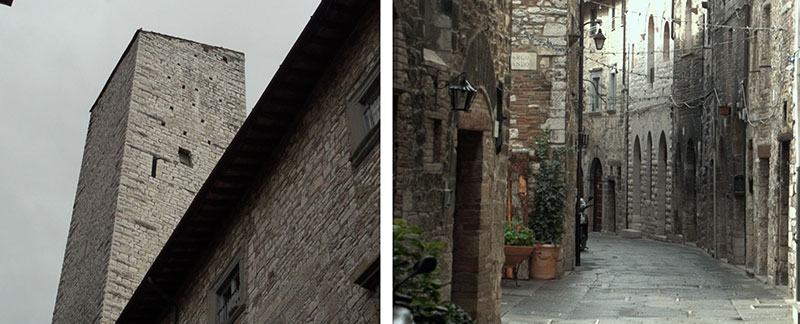
It's always essential to visit the museums and monuments and go in the main churches, have some great meals and do little shopping. But one of the most rewarding activities you can ever do when you're traveling is just simply walking through the local neighborhoods, being observant. Take a good look at what's going on, notice the buildings, the stones, pavement, people, dogs going by, the shops – just walk and listen and look. It's an enriching experience.
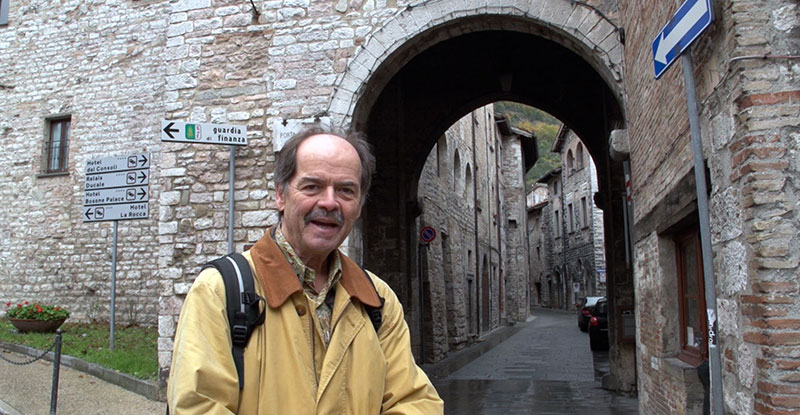
This is the borgo of Santa Lucia, part of the old town, even though it's outside the main wall. And there is another gate, the arch of Santa Croce, with another wall that helped to enclose this little district of Santa Lucia.
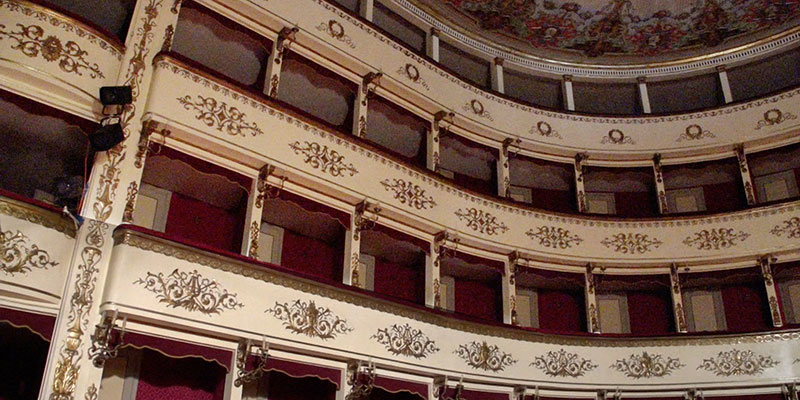
The municipal theater, Teatro Communale, was inaugurated first in 1738 and then in 1846 it was renovated and rebuilt and enlarged in a more refined style. And today it's a very active theater presenting various kinds of programs, mostly plays, as well as concerts and ballets and recitals and lectures and various community gatherings.
Via dei Consoli leads to the beautiful Palazzo dei Consoli, and the magnificent Piazza Grande. Via dei Consoli is a small street, but one of the main streets of Gubbio. It is primarily a pedestrian zone in the historic center.
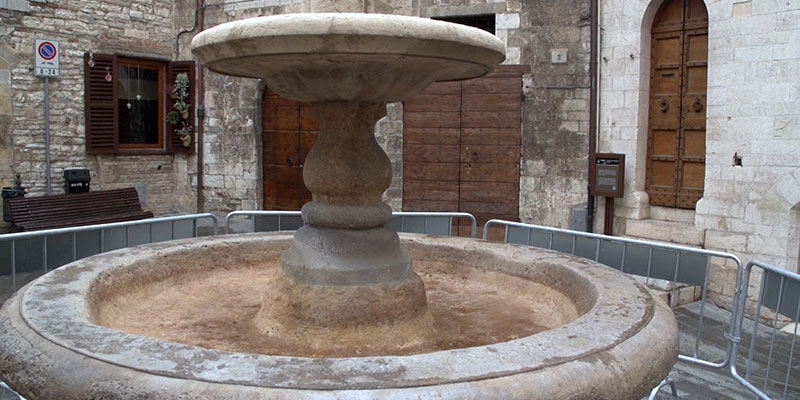
We get to Largo Bargello which has the famous fountain of the town. It was the main water source back in the medieval days for a large part of the town. Now if you run around it three times you go crazy they say.
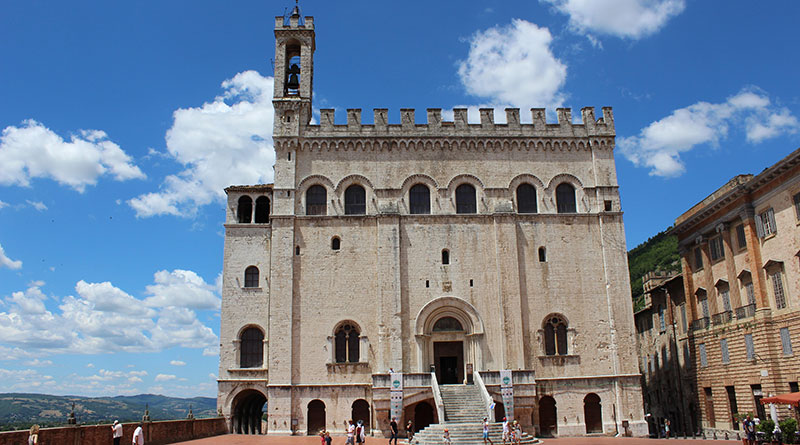
Palazzo dei Consoli was a very important palace in medieval time for the government of the people. The palace is a huge building constructed in the 14th century, with the magnificent staircase out front and towering way, way above the town. The top of the tower is 80 meters above the lowest level, which is about 250 feet high – a medieval skyscraper, really remarkable.
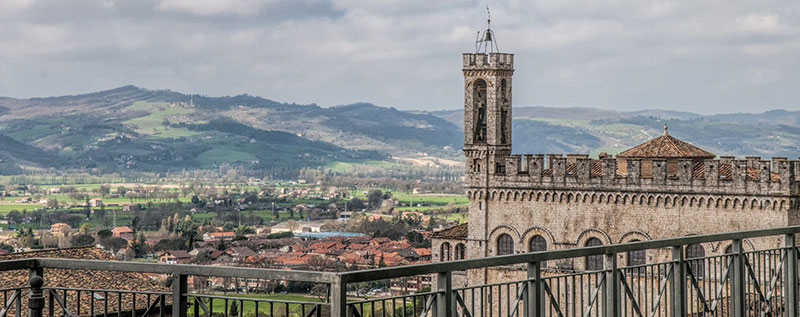
Before going inside the Palazzo take a moment to enjoy the view looking out over the stone town of Gubbio. Most of those buildings you see are about 500 years old.
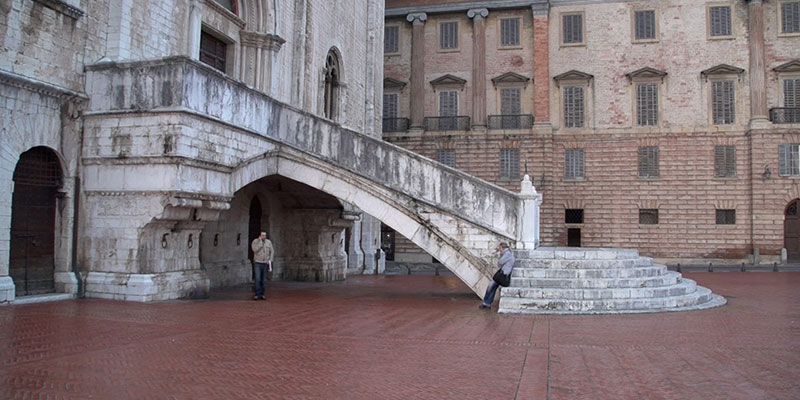
The staircase in front of the Palazzo is really quite a work of architecture. It has two levels – one takes you up to the main hall and the other to the ground floor.
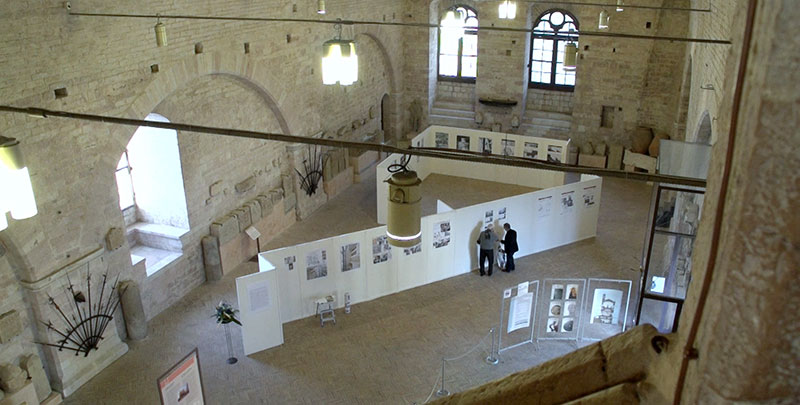
The main hall is one of the largest medieval rooms ever built. It is simply immense, occupying the entire main floor of the Palazzo dei Consoli. It was a meeting room for the leaders of the city.
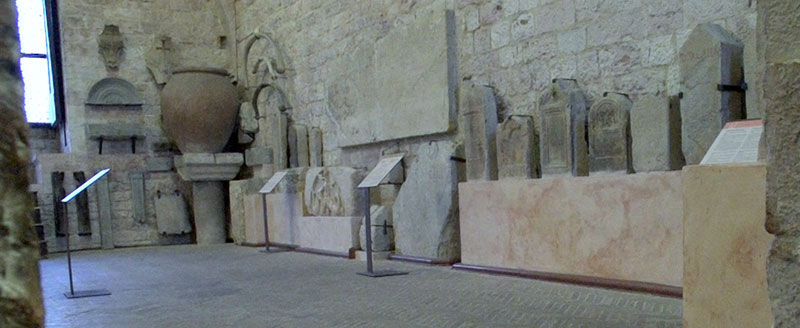
Upstairs you find a museum, picture gallery, and historic rooms with original hallways. It is an interesting museum, but the interior of the building is even more fascinating than the artifacts on exhibit.
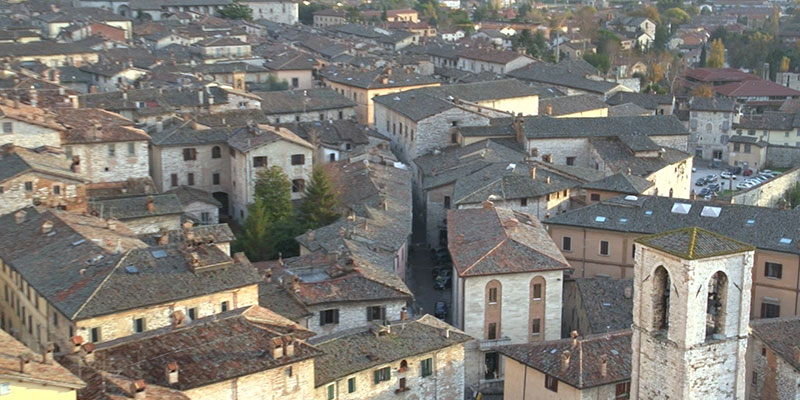
And from here you get a fantastic view looking out over the city, especially late in the afternoon as we're enjoying a bit of golden light coming in, looking down on the clay tile roofs and stone walls and narrow lanes of Gubbio.
From the other end of the terrace you have a view looking up at the Duomo – the Cathedral – and back across the Piazza Grande at the City Hall. You are free to wander throughout the museum.
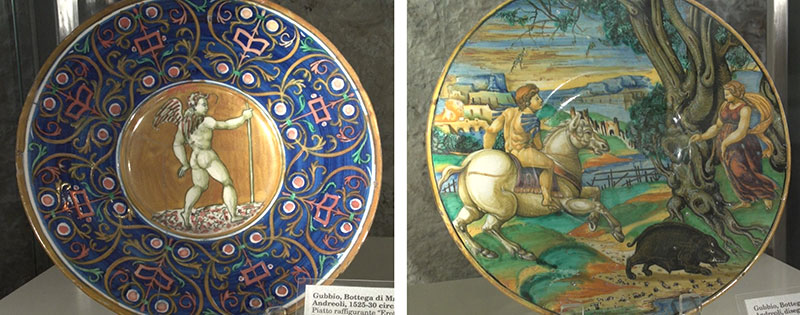
There are some important ceramic dishes here that were made by Master Giorgio. Production of ceramics is still a very important craft in Gubbio. A set of bronze tablets are over 2 1/2 thousand years old, and they're written in the ancient Umbrian script. They are the only examples of ancient Umbrian writing ever found, and they have some sort of religious meanings that have been deciphered because there's also Latin script written on the same tablets – it's like a Rosetta Stone – among the oldest written languages in Europe.
Of course the museum has a number of frescoes from the early Renaissance and the Byzantine periods, and some artifacts that go as far back as the Roman occupation of this very ancient town, as we wind down our visit to Palazzo dei Consoli.

The other important building on the piazza is the City Hall, also called the Palazzo Podesta, which was the home of the government of the city. The palace and City Hall were built about the same time in the early 1300s.
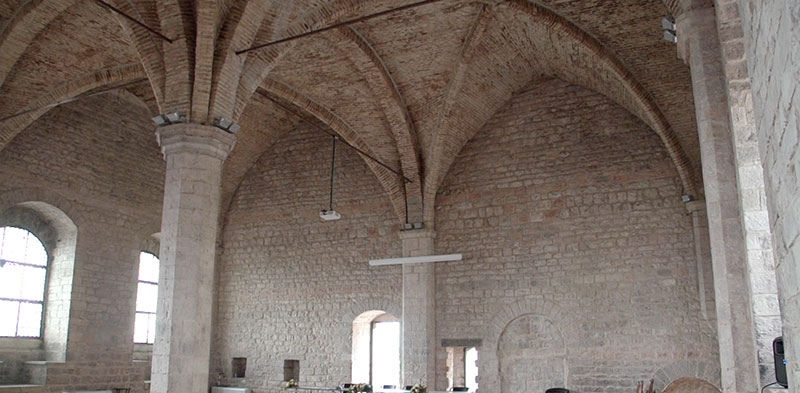
If you visit inside City Hall you'll see a medieval room of Commune di Popio, supported by an original ocatgonal column extending from the basement to the ceiling. The medieval architect Matteo Gattapone, ran this single column all the way through the building supporting all three floors.
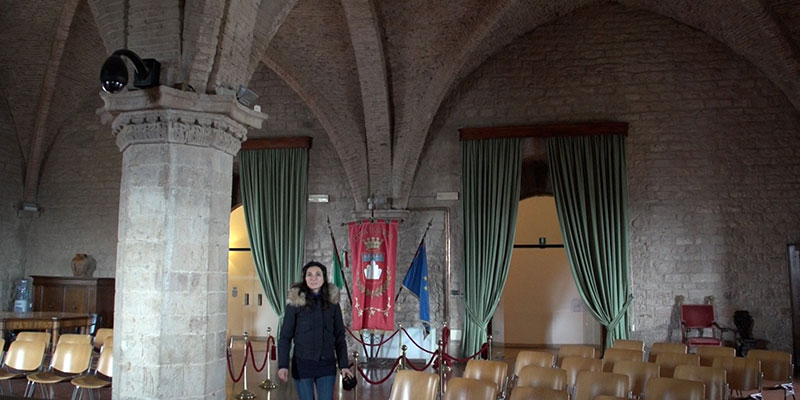
This room is Consigliare Hall for the Council, like a City Council. This is the gonfalone of the city. The symbol of the city is shown in a tapestry, with symbols including the tower of the city, five surrounding mountains, and the quercia tree. Looking out the window from City Hall, we have another fine perspective on the Piazza Grande and the Palazzo dei Consoli.
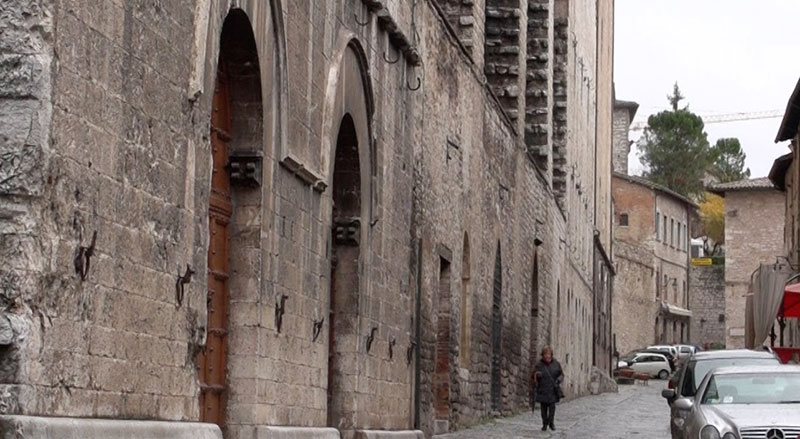
The Piazza Grande is held up by immense arches which are the foundation of the Palazzo structure, visible down below on Via Baldissini. These were built in the 1400s, but in an ancient Roman style and somewhat in emulation of ancient Rome because Gubbio saw itself as a new Rome. It's a remarkable construction holding up this great Piazza Grande, which is the main square of Gubbio. A big old wine barrel was kept underneath the Cathedral. It could hold several thousand liters of wine for the priests in the church.
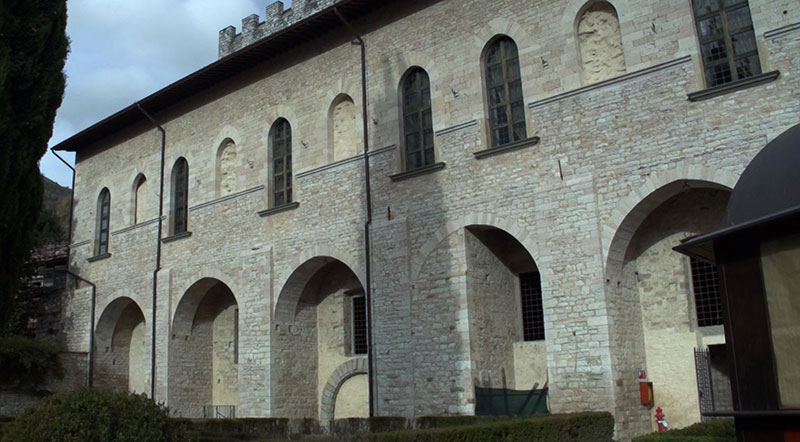
Now we're approaching the Grand Dukes Palace, the Palazzo Ducale – the ruler's home. The main leader who lived here was Federico da Montefeltro, Duca Urbino, Duke of Urbino, who ruled Gubbio and Umbria with the help of the Medici in Florence.
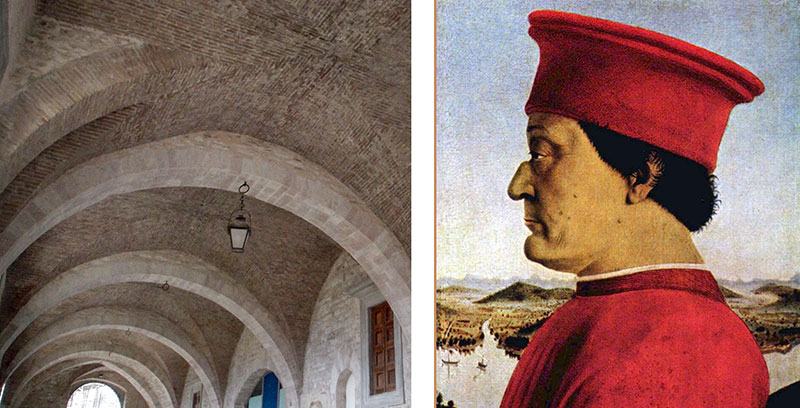
A beautiful, barrel-vaulted grand entryway leads you into this magnificent interior. You might be familiar with the Duke and his strange nose because of a famous painting hanging in Florence, by Piero della Francesca. The Duke was a very important leader in Gubbio and the region back in the 1400s. The palace was built for the Duke in the 1480s in a very central location between the other palace, the Duomo and the City Hall.
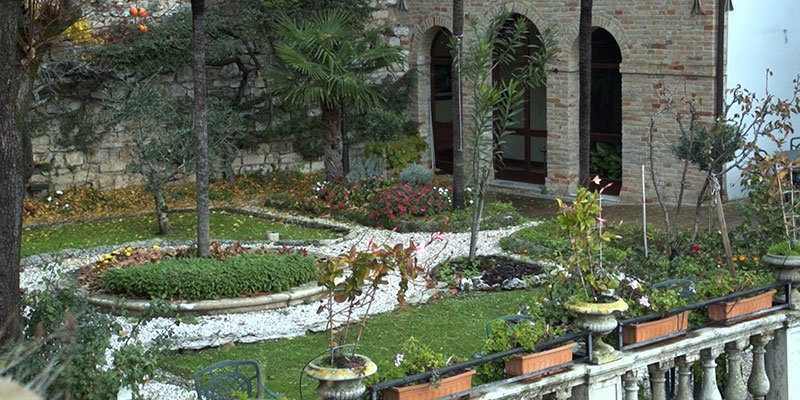
He had a lovely garden with a terrace looking out over the town, which his legacy dominated for 200 years. A smaller palace is next-door which is now a four-star hotel, called Relais Ducale.
This is a hilltown, so some of the streets are very steep and many of them are for pedestrians only. Some are staircases, too steep for a car to go up, and they are just beautiful with their flowers and plantings and gardens along the steps, and the low alleys. It's really great fun, it's like a maze to walk around in Gubbio. It does help to be in pretty good condition to able to experience these many little streets. There are three main streets: Via Gabrielli, Via Mattini, and Via 20th September, the most important street.
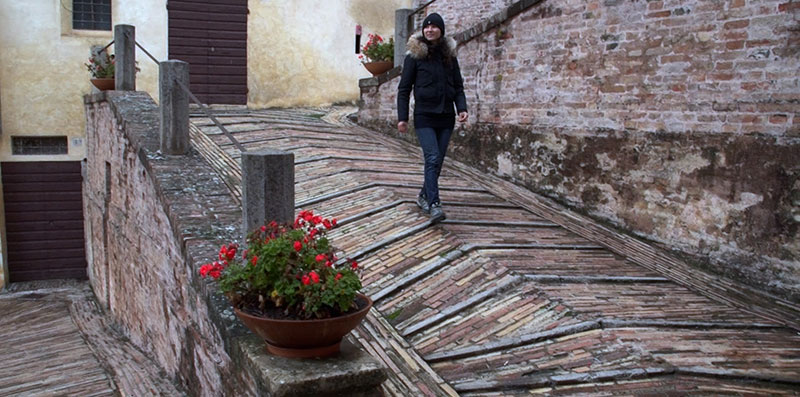
Largo of Vescovado is a narrow, curved lane heading uphill past the archives, which contains very old documents from the churches. Largo del Vescovado kind of reminds you of Lombard Street in San Francisco, except here there are no cars, it is strictly for pedestrians. Notice the brilliant design and brick paving of the walkway, which makes it very easy to walk up this little hill.
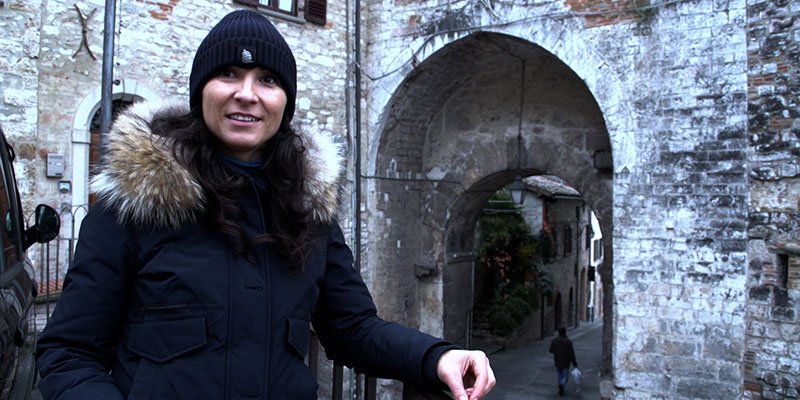
We are continuing our walk along the via 20 September passing some beautifully decorated buildings and more of the little side lanes and ancient stone buildings.
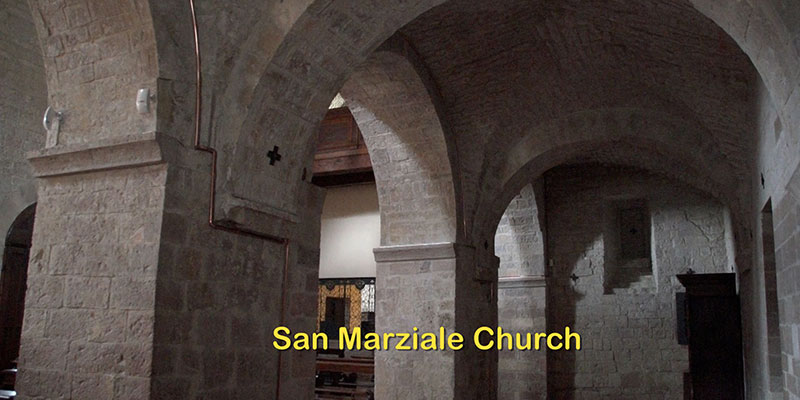
We reach the church of San Marziale, a Romanesque church. The thick columns, heavy stone construction, low ceilings and small windows are all indicators of a very old church built in the Romanesque style, older than the Gothic. San Marziale is one of the oldest churches in Gubbio.
And now get ready for a most unusual experience. We are going to the Funivia. It's like a cable car. It's like a ski lift. It's like a chairlift. And yet it's something quite unique to Gubbio.
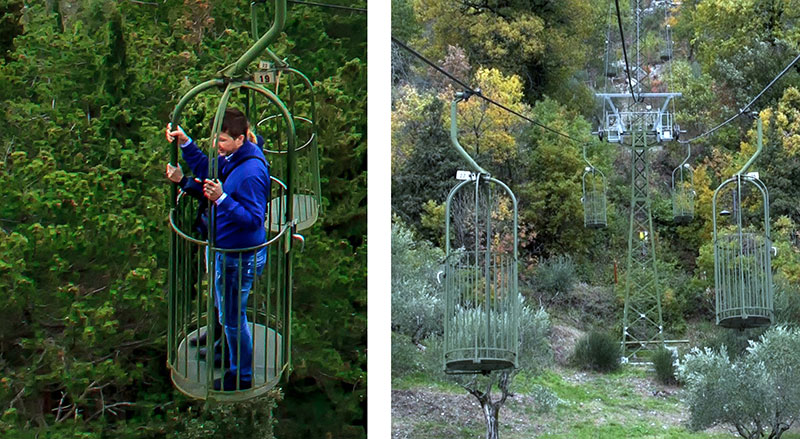
The Funivia is a little wire basket, like a birdcage that you jump into on the run. This thing doesn't stop. There is an attendant there to help you out, and you hop on board and ride up the mountain in the open-air.
Hop on the Funivia, boom, on the go. He holds it back for just a moment so you can hop in and he shuts the gate for you, and you're really quite safe and quite secure, but it's almost like you're just flying or floating. There's nothing between you and the mountain. We arrive at the top and get helped out of our little basket by another attendant.
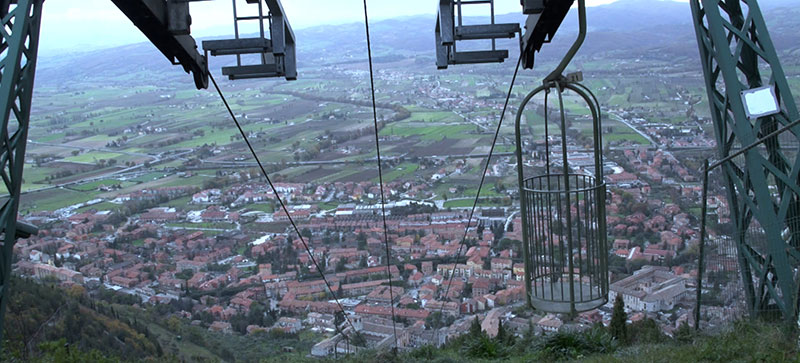
From the top you also get a great view looking down on Gubbio, at the great collection of medieval structures. There are a couple of benches with the wonderful vista down below. There are also some hiking trails up here and you could walk down if you want to, but it's easier to ride.
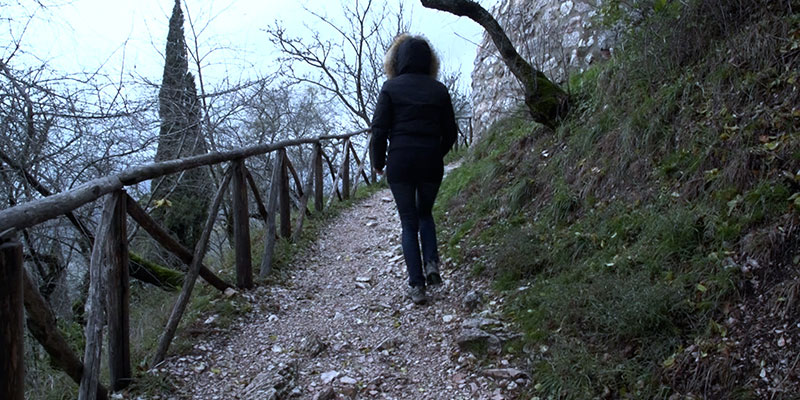
The main reason why this Funivia was constructed in the first place was to bring you up the hill so you can visit the Basilica of Sant'Ubaldo, who is the patron saint of Gubbio. He was very important religious leader about a thousand years ago. The saint is buried inside – his body is still very well preserved from a thousand years ago.
And then it's time to head on back down. You do the same routine – you hop in the basket on the run. He snaps the door shut behind you and off you go. It's like you're flying. And it's cool and breezy up there. Fortunately you're not really high above the ground so you're probably not going to get too much of a scared feeling of vertigo.
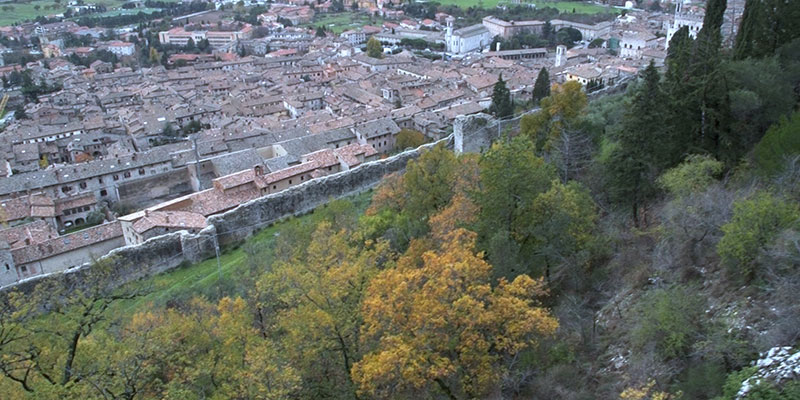
We're getting some of the taste of the fall colors as well. We were the only customers it seemed that afternoon. We're traveling in the month of November and most sites in Umbria, in general, were pretty devoid of tourists, which is really quite lovely.
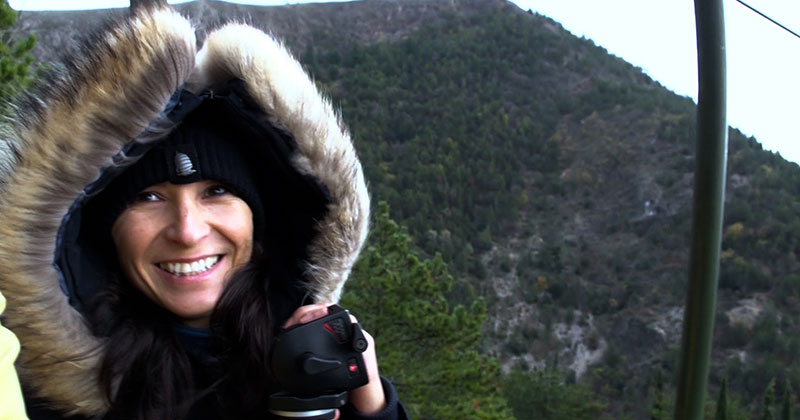
We're visiting a couple of the small shops and businesses in Gubbio and found some of the friendliest people you'll ever know. We meet the affable butcher, Francesco, who owns the salumeria, and macelleria, artisenale. Then we enjoyed some free tastings in Francesco's friendly shop. Francesco's hospitality also includes free tasting of wine.
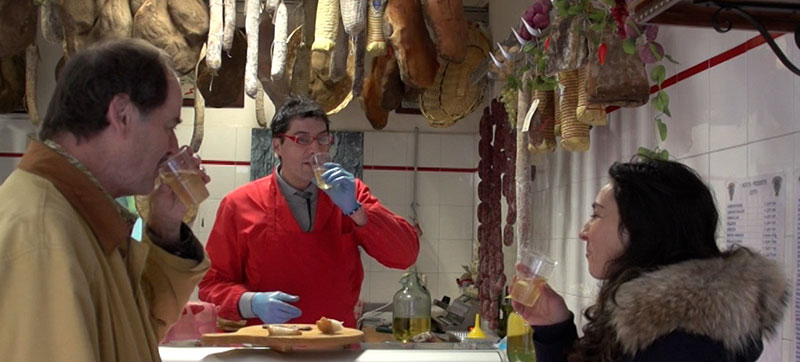
"Oh, everywhere, the wine," he says. "In this shop, house of the wine. Cin-cin, ha ha, a la salute. Cin-cin. Grazie, Francesco. "We have wine, typical wine of market. Handmade, the typical products. This is the typical sausage." Francesco doesn't sell the wine – he gives it away, making his shop very popular. Delicious. Okay. Thank you. Arrivederci. Arrivederci.
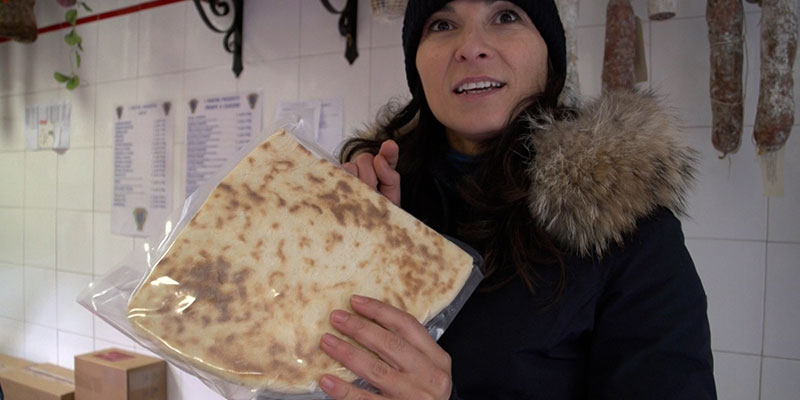
Try the crescia, a bread, pane, typical bread for a sandwich with prosciutto. Okay, so we sample the prosciutto and the fresh bread in San Martino.
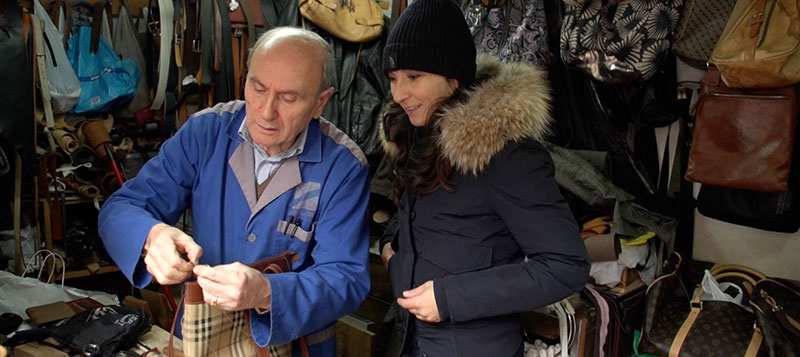
We stopped to have a look inside the leather shop at the gateway and admire the handmade bags. Then Isabella got roped into helping the repair job with her long fingers. She was able to assist this man who was fixing a strap and zipper on a bag, so she got recruited andjoined right in, small-town style.
Nearby is another gateway through the old medieval wall, the Porta Castello. And now Isabella leads us further along Via dei Consoli, one of the main streets of Gubbio, with enticing shops, cafés and restaurants.
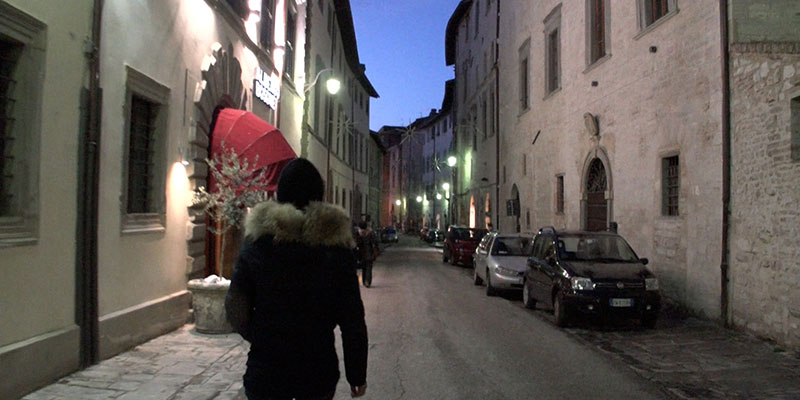
We continue walking along the 20th of September Street and up via Maestro Giorgio Street, another staircase, into some of the little alleyways in the upper town.
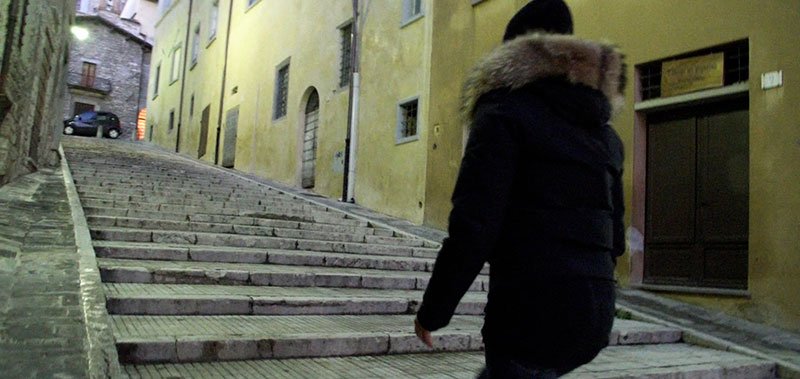
It's evening now. The sun goes down about 5 o'clock in November, so it gets dark quite early, and yet it's so atmospheric and medieval as you walk along through these lanes. And of course it's completely safe. This is a small town.
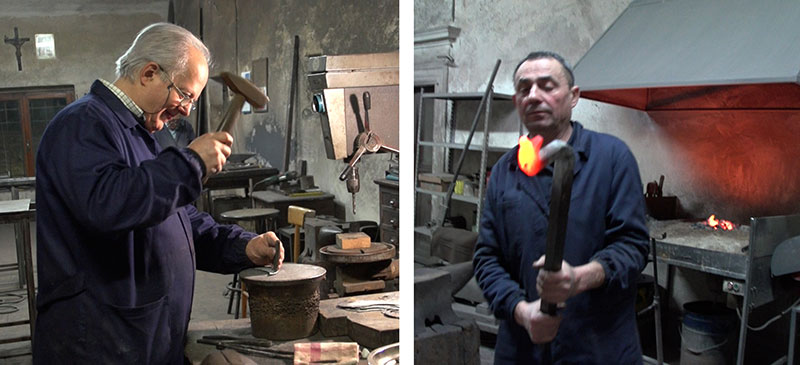
And we are invited into an interesting ironworker shop. They're pounding away on wrought iron and grinding and welding, doing all sorts of crafts and handmade work here, following a trade that's been passed down for thousands of years.
It's somewhat gratifying to know that small-scale manufacturing can still occur at the neighborhood level in a small town on a human scale like this. And they are producing quality goods that their neighbors will want to purchase.
Gubbio is world-famous for its truffles. San Francesco e il Lupo is one of the nice restaurants in Gubbio, in which you can enjoy that local delicacy, the truffle, which is found in such abundance that they even put it on pizza, and it was not terribly expensive, about 18 euro for a nice pizza.
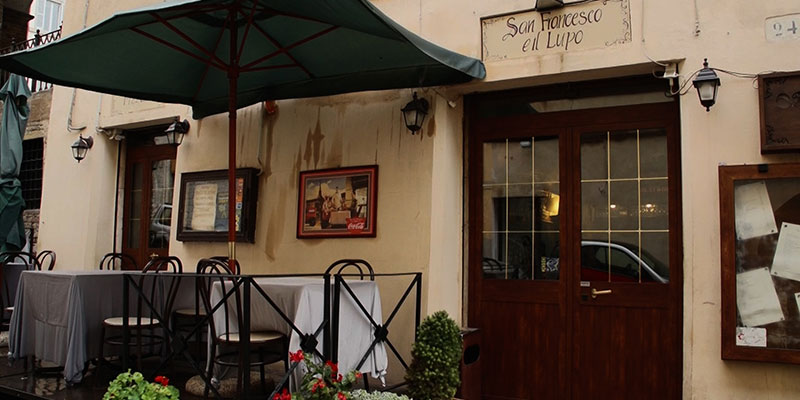
And then you move into other courses. You can have truffle on bruschetta, have truffle on your pasta, and have some truffle on your main course, some sliced beef. They put truffle on practically everything in Gubbio. It's one of the better places in the world to be hunting for truffle.
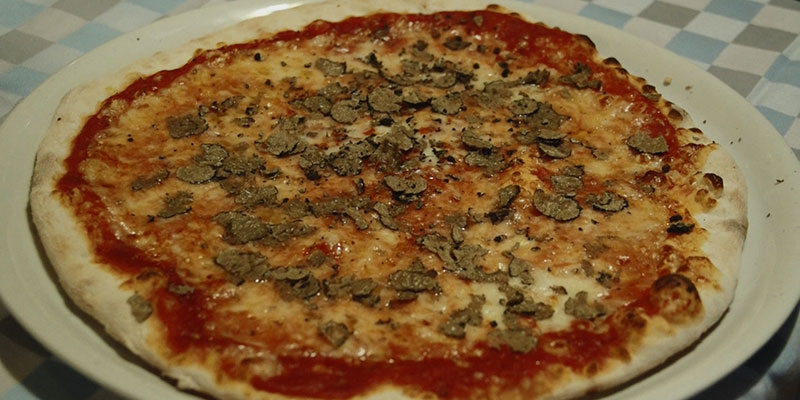
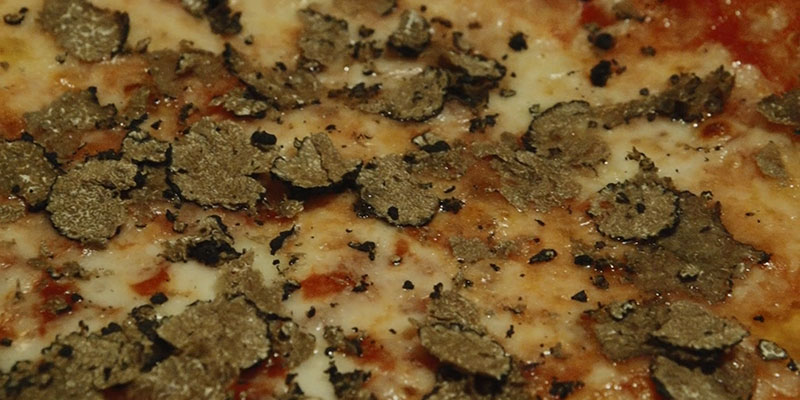
The restaurant is very friendly, not very busy in November, so the locals are here. It's almost like a family dining room and very casual – local kids come over and say hello. San Francesco e il Lupo was so nice, I went back for dinner after having lunch there. Excellent restaurant right in the heart of town at the main crossroads.
Truffles are so popular in this area, this region of Umbria, that there are several stores in town that sell truffles. You can buy the raw truffle or buy them in jars in a sauce to take home with you.
Isabella leads us further along Via dei Consoli, and we visited her favorite truffle shop, Tartufi di Gubbio.
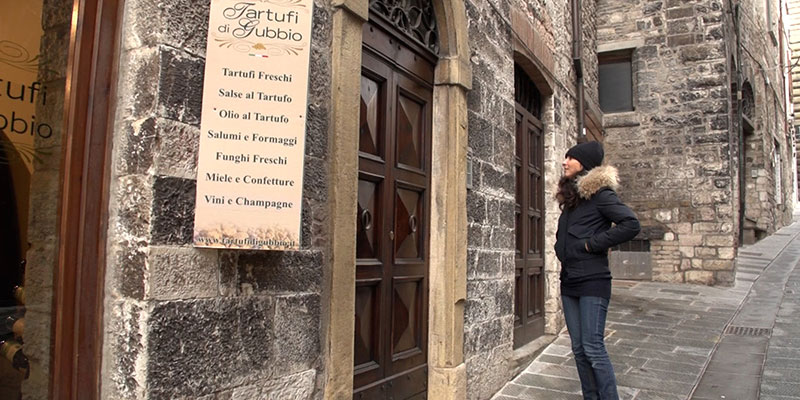
"Tell me the price, how much for the whole basket? €280 for 100 grams. This is? 400 grams. So about €1000, uh-huh. In this, the black one, €80 for 100 grams, the summer black truffle, too. Oh different. Different. It's more expensive. Different quality. More flavor yes, stronger. The white one, it's made for pasta. This is the white truffle inside, and this black truffle inside, and mushrooms too. This, the black one is special for, how do you say in English, sauce? Sauce. Bruschetta. Bruschetta, yes. Hot and cold bruschetta, okay? And this is also a pure black truffle. Pure black truffle, pure. In oil, olive oil, wow. So, what do you think? It's good? Very, very good. I like it, ha ha. With pasta, bruschetta, rice, with eggs, frittata. Mmmh, frittata. Special eggs, special.
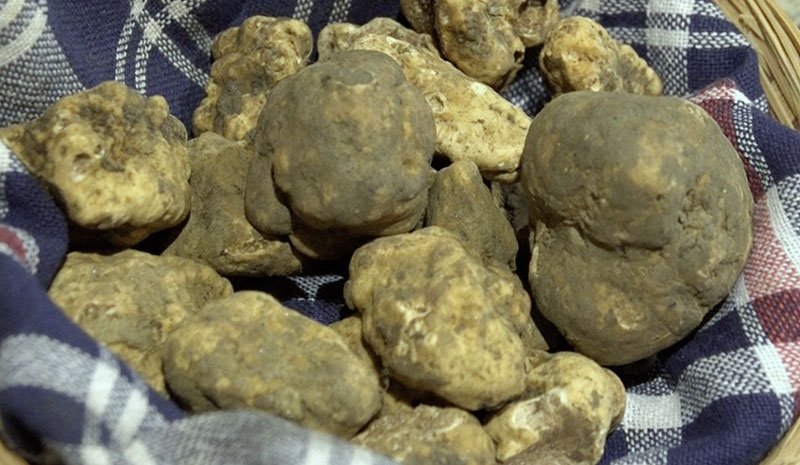
"And so these are from Gubbio, from the area? Yes this is, this truffle is from the area of Gubbio. Mountain of Gubbio, Apenino. So is it one of Italy's best truffle areas? Yes, it's the very best area of the truffle, yes. Wow. This shop is here, over there, and this is the big tree of Christmas, and in these mountains you can find truffles. Oh, I see. In France they have the perigord. What's your name? Francesca."
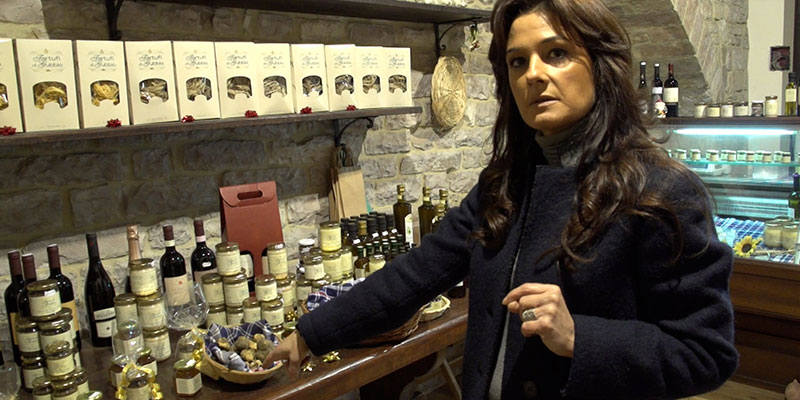
It's remarkable that Gubbio has three different kinds of truffles, and they're in season for half the year.
And then something wonderful happened. Isabella invited me to come home and have dinner with the family and it turned out to be a marvelous evening.
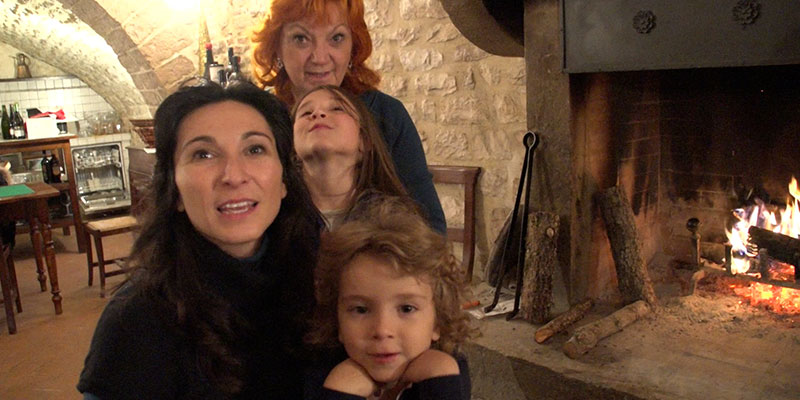
"Ciao Dennis. Julio. Julio and Camilla. Cammilla and Julio. Ciao. Ciao again. In the taverna, we have the fire – beautiful fire, ha ha." And we meet Isabella's mother, Miranda, who is also quite a world traveler.
Their dining room was a taverna hundreds of years ago, and now it's a beautiful place where the kids can play soccer indoors on roller-skates, Italian style. They live in a multilevel medieval stone building in the heart of Gubbio with three apartments for family and friends. When the kids found out that I'm from Hawaii they did a hula for me. Amazing that the hula is known all over the world from little Hawaii to little Gubbio – being entertained by little Italian hula dancers. This was too much for me. Yeah, yeah, yeah, beautiful.
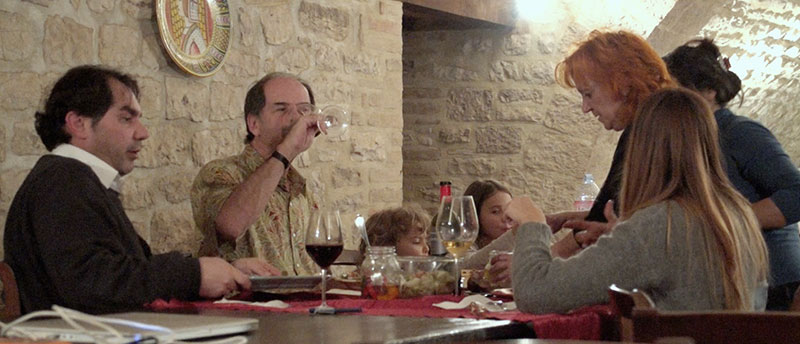
Then we sat down and ate dinner – oh! What a meal! And the wines. Isabella is actually a sommelier. She is not a professional tour guide, and her friend is also a sommelier. They were heading out the next morning to do some wine tasting and purchasing for local restaurants.
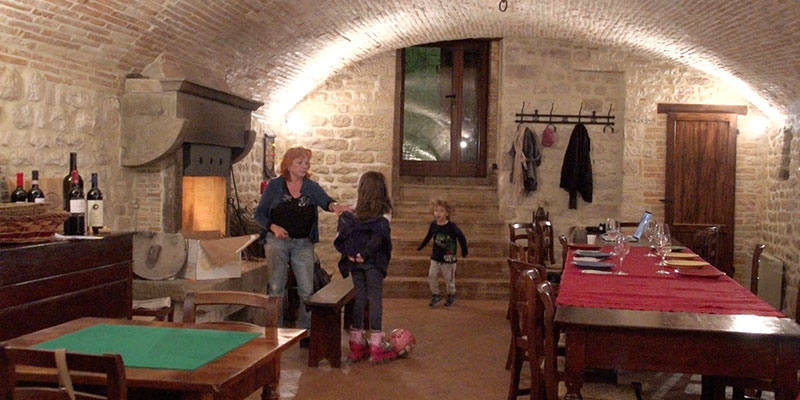
And it was just a great evening with family and friends at home in Gubbio, one of the nicest nights I've ever had in my travels. The food was delicious, company was great, wine was excellent, of course. Everybody had a good time. It turns out that hospitality is an honored tradition in Gubbio that dates back to the Middle Ages. When the nobles wanted to entertain a stranger coming through town they had to compete for the attention of these visitors.
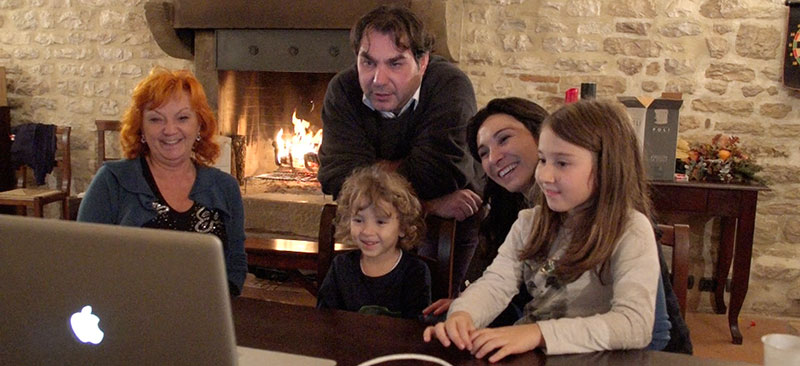
And then we had some fun watching the movie that Isabella and I had just been making, in walking around Gubbio that same day. I made a quick cut rough edit to show the family that same night, and we all had a blast watching the mini world premiere of the movie. Dinner with Isabella and friends and family in Gubbio was one of the great experiences of all my Europe travels.